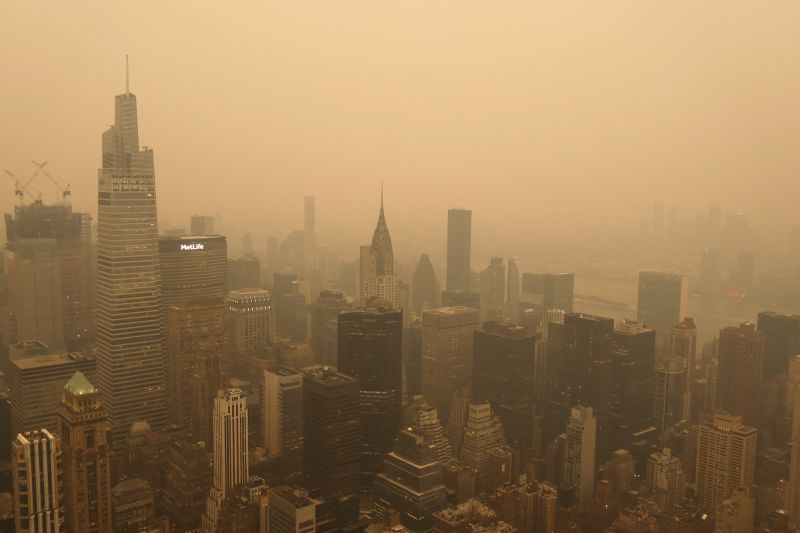
New York residents urged to stay indoors as unhealthy air quality from Canadian wildfires persists
As an orange haze of wildfire smoke from Canada hovers over parts of the Northeast and Mid-Atlantic regions, officials in New York state are warning residents to avoid being outdoors due to the potential health risk that could persist Wednesday.
New York City had the world’s worst air pollution of any major city during parts of Tuesday as heavy smoke from more than 100 wildfires burning north of the Canadian border drifted south.
The smoke has also triggered air quality alerts in parts of Massachusetts, New Hampshire, Pennsylvania, Maryland, Virginia and the Carolinas, according to the National Weather Service.
The alarming air quality, a degree of which could continue Wednesday, prompted New York Mayor Eric Adams to ask residents to limit their outdoor activity and state environmental officials to issue an air quality health advisory for the city through Wednesday.
“Active children, adults, and people with lung diseases such as asthma should reduce prolonged or heavy exertion outdoors,” officials advised.
New York City public schools canceled all outdoor activities Wednesday, but will remain open. At least 10 school districts in central New York state canceled outdoor activities and events Tuesday.
By 7 a.m. Wednesday, New York City’s air quality index was just below 180, a designation of “unhealthy,” according to IQair.
Overnight Tuesday into Wednesday, the air quality index for the city topped 200, pushing it into the “very unhealthy” range, according to IQair.
New York City tallied to the worst air quality of any major metropolitan area Tuesday at 10 p.m., IQair’s data showed.
Later Tuesday night it had the second-worst in the world, after New Delhi, India, IQair reported. Other cities on the list were Doha, Qatar; Baghdad, Iraq; and Lahore, Pakistan.
Air quality in the northeast US has deteriorated this week as more than 150 wildfires rage in Quebec, according to the Canadian Interagency Forest Fire Center.
So far this year, the province has experienced more than 400 wildfires, which is twice the average for this time of year.
More than 9 million acres have been charred by wildfires in all of Canada this year – about 15 times the normal burned area for this point in the year.
Human-induced climate change has exacerbated the hot and dry conditions that fuel wildfires. Scientists recently reported that millions of acres scorched by wildfires in the Western US and Canada – an area roughly the size of South Carolina – could be traced back to carbon pollution from the world’s largest fossil fuel and cement companies.
Air quality concerns span multiple states
On Wednesday, the heaviest smoke is forecast to impact the Northeast through the mid-Atlantic and down to the Carolinas. Smoke conditions in those regions could also persist through at least Thursday.
Cities including New York, Philadelphia and Washington, DC, are expected to see their air quality improve throughout the day.
But the air over Boston, Pittsburgh and Raleigh, North Carolina, is forecast to worsen Wednesday.
Wildfire smoke is particularly dangerous because it contains tiny particulate matter, or PM2.5 – the tiniest of pollutants.
When inhaled, it can travel deep into lung tissue and enter the bloodstream. It comes from sources like the combustion of fossil fuels, dust storms and wildfires, and has been linked to a several health complications including asthma, heart disease and other respiratory illnesses.
And the impacts could be deadly: In 2016, about 4.2 million premature deaths were associated with fine particulate matter, according to the World Health Organization.
“If you can see or smell smoke, know that you’re being exposed,” said William Barrett, the national senior director of clean air advocacy with the American Lung Association. “And it’s important that you do everything you can to remain indoors during those high, high pollution episodes, and it’s really important to keep an eye on your health or any development of symptoms.”
